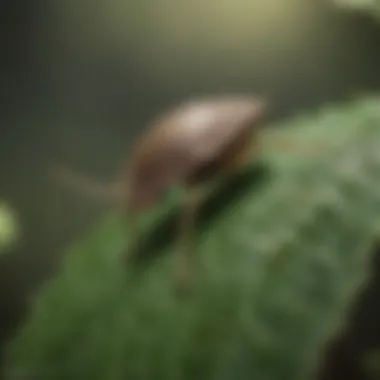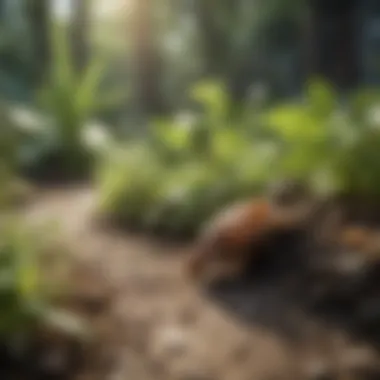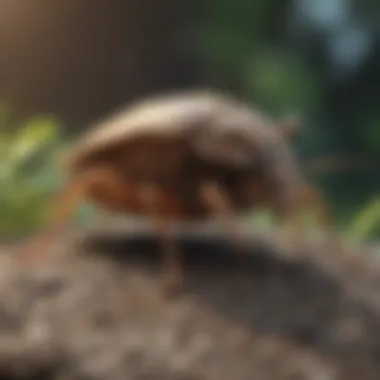Effective Strategies for Controlling Stink Bugs


Intro
Fascinating Facts About the Animal
Stink bugs, primarily belonging to the family Pentatomidae, are known for their unfortunate characteristic: releasing a strong odor when threatened. This scent is meant to deter predators and serves as a defense mechanism.
Unique Characteristics
One notable feature is the shape of their bodies, which is generally shield-like. Their coloration can vary, ranging from brown to green, depending on the species. The common brown marmorated stink bug is particularly well-known for its gray-brown color and white banding on its antennae and wings.
Extraordinary Abilities
Stink bugs are capable flyers and can travel significant distances in search of food and suitable habitats. They feed primarily on plant sap, making them a danger to crops. Their piercing mouthparts enable them to extract fluids from various plants, leading to wilting and potential crop failure.
Behavior and Habitat
Understanding stink bug behavior is essential for effective control.
Natural Habitats
These insects typically thrive in agricultural areas, gardens, and fields. In the wild, they prefer a habitat with abundant vegetation. Their preference for specific plant types can lead to localized infestations.
Social Structures
Stink bugs are primarily solitary, but during mating season, they can be found in larger groups. This behavior can lead to significant numbers within a designated area, resulting in substantial damage to crops and gardens.
Recent Scientific Discoveries
Research continues to advance our understanding of stink bugs and their impact on ecosystems.
Latest Research Findings
Recent studies highlight their ability to reproduce quickly, with females laying up to 400 eggs in one season. This rapid population growth necessitates timely intervention strategies for control.
Breakthroughs in Animal Biology
Scientists are exploring biological control methods, such as the use of natural predators. The potential application of biocontrol agents may present a sustainable solution to managing stink bug populations in both homes and fields.
Cultural Significance
The impact of stink bugs extends beyond agriculture.
Animals in Folklore
While stink bugs may not have an extensive presence in folklore, their reputation for smell has made them a subject of various local tales. These stories often warn of the pest's negative impact on crops and homes.
Influence on Art and Literature
Stink bugs have found their way into literature as symbols of persistence and survival, often mentioned in the context of nature’s balance. Their biology and behavior can serve as metaphors for resilience under pressure.
Prologue to Stink Bugs
Understanding stink bugs is essential for effectively managing an infestation. These insects, apart from their unpleasant odor, can cause significant damage to crops and structures. They are particularly notorious for their ability to invade homes in search of warmth during cooler months. Recognizing their behavior and biology aids homeowners and agricultural professionals in implementing appropriate control strategies. In this section, we will look into the nature of stink bugs and the common species that people may encounter.
Understanding Stink Bugs


Stink bugs belong to the family Pentatomidae, and their name reflects the foul smell they emit when disturbed. This odor serves as a defense mechanism against predators. The insects typically measure about half an inch to three-quarters of an inch in length and have a shield-like shape. They can be found in various colors, including green, brown, and gray. Their life cycles consist of three main stages: egg, nymph, and adult. The nymphs resemble smaller adults but lack wings and can have varying colors. Overall, stink bugs are more than a mere nuisance; they are persistent pests that can diminish crop yields, leading to economic losses for farmers.
Common Species of Stink Bugs
There are several species of stink bugs, but some are more prevalent and problematic than others. These include the following:
- Brown Marmorated Stink Bug: This species is highly invasive, first identified in the United States in the late 1990s. It prefers fruits and vegetables, causing substantial agricultural damage.
- Green Stink Bug: Commonly found in gardens, it targets various plants and crops, making it a threat to home gardens.
- Spined Soldier Bug: While this species is a predator of pests, it can also feed on crops if populations increase.
Recognizing these species and their characteristics helps manage their populations effectively. Awareness of their habits and preferred environments allows for better preventive measures.
Identifying a Stink Bug Infestation
Identifying a stink bug infestation is a critical step in effective pest management. Understanding how to recognize these pests early can save a homeowner significant time and resources. Stink bugs are known for their distinctive smell when crushed, and they can quickly become a nuisance both indoors and outdoors.
Effective identification allows for prompt action. This stops the pests from multiplying and causing greater damage. Furthermore, familiarity with their behavior and habits helps in selecting the appropriate control measures. In the following sections, we will explore the specific signs of infestation and how to assess the damage they have caused.
Signs of Infestation
Recognizing the signs of a stink bug infestation requires careful observation. One of the most noticeable indicators is the presence of stink bugs themselves.
- Sighting Adult Stink Bugs: Adult stink bugs are usually about 0.5 inches in size and have a shield-like shape. Their coloration may vary, often seen in shades of green or brown.
- Smell: The most characteristic feature of stink bugs is their odor. When disturbed or crushed, they emit a pungent smell that can be quite unpleasant.
- Damaged Plants: Look for signs of damage on plants, such as yellowing leaves, wilting, or dark spots. This indicates that stink bugs may be feeding on them.
- Egg Clusters: Female stink bugs lay clusters of eggs on the underside of leaves, usually tending to be a yellow or green color. Finding these can alert you to an emerging infestation.
Monitoring areas near windows, doors, and plants can reveal a growing population. If multiple signs are noticed simultaneously, it is likely that action is needed soon.
Assessing the Damage
Once a stink bug infestation is confirmed, assessing the damage is vital for planning an effective control strategy. Stink bugs primarily feed on the sap of plants, so the impact can vary based on host plant type and the extent of the infestation.
- Leaf Damage: Discoloration, holes, or wilting leaves signal that stink bugs have been feeding. The leaves can also drop prematurely in serious cases.
- Fruit Deformities: In crops such as tomatoes, peppers, and fruits, feeding by stink bugs can result in scars and deformities, making them less marketable.
- Comparative Analysis: Check surrounding plants to determine the scope of the infestation. This helps in understanding whether it is localized or widespread.
Effective assessment can guide homeowners in their approach. Knowing the extent of damage aids in deciding whether to manage the problem on their own or seek professional help.
Preventive Measures Against Stink Bugs
Preventive measures against stink bugs are essential in managing infestations before they become a significant problem. By focusing on areas where stink bugs might enter homes or damage crops, preventive strategies can reduce the need for more intensive control measures.
Stink bugs are known for their persistence, and once they establish themselves, getting rid of them can be quite challenging. Therefore, taking proactive steps is the most effective way to handle these pests. Additionally, prevention helps save time and resources in the long run. The next sections will discuss two critical preventive measures: sealing entry points and landscape management.
Seal Entry Points
Sealing entry points involves identifying and closing off cracks and gaps around the home. Stink bugs often enter buildings through small openings found in windows, doors, and vents.
An effective approach includes the following:
- Inspecting windows and doors: Ensure screens are intact and close tightly.
- Using caulk or weather stripping: Filling gaps with these materials can significantly reduce access.
- Examining utility entry points: Check areas where pipes and wires enter the house to see if they need sealing.
By sealing these entry points, you create a barrier that deters stink bugs from entering your living space, leading to fewer infestations.
Landscape Management
Landscape management includes strategies related to choosing the right plants and maintaining the property. These practices can significantly reduce the likelihood of infestations.
Proper Plant Selection
Proper plant selection is about choosing species that naturally repel stink bugs. Some plants like marigolds and basil can act as deterrents due to their strong scents. By incorporating these into a garden, one can create an environment that is less appealing to stink bugs.
The key characteristic of this method is its preventative nature. Rather than trying to eliminate pests after they invade, it minimizes the chances of them being attracted to your area in the first place. An advantage of using these plants is they not only deter stink bugs but can also attract beneficial insects, which help in maintaining a balanced ecosystem.


However, it is essential to research the specific plants suitable for your locality. Each region has its own native species that can be beneficial, and ensuring you choose those that thrive in your environment is crucial to the overall success of your efforts.
Regular Landscaping Maintenance
Regular landscaping maintenance keeps the garden tidy and less inviting for stink bugs. This includes practices like trimming back excessive foliage and keeping plant debris cleared from the ground.
The key characteristic of maintaining a clean garden is that it removes hiding places for stink bugs. An advantage is that simple actions like pruning and cleanup can also enhance the overall appearance of the property. However, regular maintenance requires commitment and effort, which can be seen as a disadvantage for some individuals.
Keeping your landscape well-maintained not only prevents stink bugs but also promotes healthier plants overall.
Natural Methods for Stink Bug Control
Natural methods for controlling stink bugs focus on harnessing ecological balances rather than chemical interventions. These methods are significant in this article because they promote sustainable practices that protect the environment. Incorporating these techniques helps manage stink bug populations without introducing harmful substances. Natural controls can often be as effective as synthetic options, with the added benefit of being safer for families and pets.
Using Essential Oils
Essential oils have gained recognition for their repellent properties. Oils like peppermint, neem, and lavender contain compounds that are undesirable for stink bugs. When applied around entry points or directly onto plants, these oils create a barrier that keeps stink bugs at bay.
The benefit of using essential oils lies in their dual purpose. Not only do they repel stink bugs, but they also can enhance the aroma of your home or garden. They are generally safer than traditional pesticides, making them suitable for those concerned about chemical usage. However, it is essential to note that the effectiveness of essential oils may vary, and reapplication is often necessary for continued control.
Attracting Natural Predators
Attracting natural predators is an effective strategy in integrated pest management. By inviting beneficial animals into your garden, you foster a balance that lowers stink bug numbers naturally.
Birds
Birds play a critical role in controlling stink bug populations. They are natural hunters, and many species actively seek out these pests as food. For instance, blue jays and sparrows are known for their appetite for stink bugs. This characteristic makes them a popular choice for gardeners aiming to manage pests without pesticides.
Moreover, birds provide a unique feature: their ability to cover wide areas while searching for food. This attribute can lead to significant reductions in stink bug numbers across a large garden space. However, one must consider that not all birds are equally effective. Some may prefer other food sources. Providing suitable habitats, such as birdhouses and feeders, can encourage their presence but does require an initial effort.
Beneficial Insects
Beneficial insects, such as parasitoid wasps and spiders, contribute significantly to pest control. These insects prey on stink bugs, helping to regulate their population. The key characteristic of beneficial insects is their life cycle; many reproduce quickly, which allows them to respond rapidly to pest outbreaks.
A notable unique feature of these insects is their ability to seek out target pests effectively. This natural predation offers a reliable control method. However, promoting beneficial insects requires incorporating diverse plant species to create a habitat conducive for them. While this practice can take time, investing in healthy ecosystems pays off in the long run through reduced pest pressures.
Integrating natural methods not only helps in managing stink bugs but also supports a thriving environment, promoting biodiversity.
Chemical Control Options
Chemical control options play a critical role in managing stink bug populations, especially when other methods are insufficient. This section will focus on how to effectively choose the right products and the techniques for their application. Chemical control is often viewed as a last resort, meant for those situations where stink bugs have proliferated beyond manageable levels. It is important to emphasize that this approach should be taken with caution, considering both the effectiveness and the potential impacts on the environment and non-target organisms.
Choosing the Right Pesticide
Selecting the correct pesticide is essential for effective stink bug management. Different pesticides have varying modes of action and effectiveness against specific species. Here are some factors to consider when making your choice:
- Target Species: Ensure the pesticide specifically targets the stink bug species present in your area. Some products may be more effective against certain types.
- Active Ingredients: Look for active ingredients known to be effective against stink bugs. Commonly used ingredients include pyrethroids and neonicotinoids. Always read the label to ensure the pesticide is approved for use in your locality.
- Safety Considerations: Evaluate the safety of the products for humans, pets, and beneficial insects. Some pesticides can be harmful to pollinators, a crucial component of the ecosystem.
- Regulatory Compliance: Check local regulations regarding pesticide use. Some areas may have restrictions on specific chemicals due to environmental concerns.
Application Techniques
Once the right pesticide has been chosen, proper application techniques are key to maximizing its effectiveness. Here are some recommended practices:
- Timing of Application: Apply pesticides at times when stink bugs are most active. Early morning or late evening can be optimal.
- Targeted Application: Focus on areas where stink bugs are known to congregate, such as around entry points, cracks, and specific plants in the landscape.
- Spray Uniformly: Ensure even and thorough coverage of the area being treated. Uneven application can lead to resistant populations if some pests survive.
- Follow Label Instructions: Adhere strictly to the pesticide label for quantity and frequency of application. Overuse can lead to resistance and environmental harm.
Proper pesticide management not only controls stink bugs but also protects beneficial species in your garden and farm.
Employing these chemical control options, in conjunction with preventive and natural methods, can effectively reduce the impact of stink bugs on crops and homes. It is important to continually assess the effectiveness of your chosen methods and adjust accordingly, ensuring a comprehensive and sustainable approach to pest management.


When to Seek Professional Help
Understanding when to consult professionals regarding stink bug control is crucial for effective management. This decision helps in timely intervention, minimizing damage to crops and homes. Stink bugs can reproduce rapidly and cause extensive harm if left unchecked. Therefore, recognizing the signs that require expert assistance is valuable.
Indicators for Professional Intervention
There are several indicators that may suggest when it is prudent to call in pest control specialists for stink bug issues. Some of these signs include:
- Widespread Infestation: If stink bugs are frequently seen in large numbers, it indicates a significant problem that may require professional help.
- Persistent Damage: If plants or crops are showing severe signs of distress, such as wilting or discoloration, and home remedies are ineffective, consulting an expert is advisable.
- Ineffective Home Treatments: When DIY solutions fail to yield results, it is an indication that the infestation may be beyond typical household measures.
- Health Concerns: Allergic reactions or respiratory issues related to stink bugs can compel the need for professional intervention.
Recognizing these indicators early can prevent further escalation of the problem.
Choosing a Pest Control Service
Selecting the right pest control service is critical for effective stink bug management. Not all pest control professionals are the same. Here are some factors to consider:
- Experience and Expertise: Research companies with specific experience tackling stink bugs. Knowledgeable professionals will understand the pest’s behavior and breeding habits.
- Integrated Pest Management (IPM): Opt for services that utilize IPM practices. This approach combines biological, cultural, and chemical methods to minimize harm to the environment while effectively managing pests.
- Reputation and Reviews: Look for feedback from previous clients. Online resources can provide insights into a service provider's effectiveness.
- Transparency: The service should provide clear information about their methods, products used, and costs involved.
- Customer Support: Quality pest control services offer ongoing support and follow-up to ensure treatments remain effective over time.
By carefully evaluating these criteria, you can choose a pest control service that will ensure long-term relief from stink bug infestations, resulting in peace of mind for homeowners and farmers alike.
The key to successful stink bug management lies in knowing when to act and who to call for help.
Potential Risks of Stink Bugs
Stink bugs are not just a nuisance; they also present significant risks to agriculture and human health. Understanding these potential risks is crucial in order to manage them effectively. By being aware of the consequences that stink bugs can have, individuals, families, and agricultural professionals can implement strategies that mitigate their impacts.
Effects on Agriculture
Stink bugs can cause severe damage to crops, notably to fruits and vegetables. They feed on the sap of plants, which can lead to discoloration, deformation, and a decrease in crop yield. Communities that rely on agriculture are particularly vulnerable to infestations. The following points highlight the specific ways stink bugs affect agriculture:
- Direct Damage: The feeding habits of stink bugs can result in marked losses in quantity and quality of produce. Affected crops may display symptoms such as browning or stunted growth.
- Reduced Market Value: Products compromised by stink bug activity are less appealing, which may result in reduced economic returns for farmers.
- Spread of Diseases: As stink bugs feed, they can also serve as vectors for plant pathogens, compounding the damage by introducing diseases to otherwise healthy plants. This linkage further complicates pest management and agricultural practices.
According to agricultural studies, the economic impact of stink bug infestations can reach millions of dollars, highlighting the importance of rapid control efforts.
Effective monitoring and early intervention are essential in safeguarding crops. Farmers should regularly inspect their fields and remain informed about pest behavior to make timely decisions for control measures.
Health Hazards
While stink bugs primarily affect crops, they can also indirectly pose health risks. Their secretions can irritate human skin and mucous membranes, leading to discomfort. The following aspects outline the potential health hazards associated with stink bugs:
- Allergic Reactions: Some individuals may develop allergies to stink bugs. Symptoms can vary from mild irritation to more severe allergic responses. This varies significantly among individuals, emphasizing the need for awareness, particularly in sensitive populations.
- Respiratory Issues: There is potential for respiratory problems from inhaling pests or their drippings. For those with asthma or similar conditions, this can exacerbate existing issues.
- General Disturbance: The presence of large infestations in or around homes can cause a significant emotional and psychological burden. This may lead residents to feel anxious or uncomfortable in their living spaces.
It is essential to approach stink bug management with careful consideration of both agricultural and health implications. Coordinating pest control strategies effectively ensures that both crops and human living conditions are safeguarded.
Closure
In this article, we have explored the various techniques for effective stink bug control. The significance of managing stink bugs cannot be understated, particularly when considering their impact on both agriculture and residential settings. These pests can cause serious damage to crops and can be a nuisance when they invade living spaces. Implementing control strategies is essential in minimizing their presence and mitigating potential harm.
Summary of Control Strategies
To effectively eridicate stink bugs, it is important to employ a combination of strategies. These include:
- Preventive measures, such as sealing entry points in homes and manage the surrounding landscape.
- Natural methods, which involve utilizing essential oils or attracting beneficial insects and birds to help control the population.
- Chemical control options that are designed to target stink bugs specifically without threatening the safety of other wildlife.
These methods are not mutually exclusive. A combined approach tends to yield better results. For instance, sealing off homes while also using natural deterrents can create a less conducive environment for stink bugs.
Future Considerations in Stink Bug Management
Looking ahead, understanding and adapting to the behaviors and life cycles of stink bugs will be crucial. Research continues to evolve around these pests, offering new insights into their management. Strategies that focus on integrated pest management are likely to gain momentum. This emphasizes:
- Continuous education for homeowners and agricultural professionals about the latest control techniques.
- The importance of monitoring and assessing stink bug populations over time, which can guide more targeted interventions.
- The potential role of biotechnology in developing more effective control measures, such as plant varieties that are resistant to these pests.
In summary, stink bug management requires a multifaceted approach that evolves with the pests themselves. Commitment to sustainable practices will ensure long-term success in controlling these pests while maintaining ecological balance.







